A Great Idea
As society becomes more aware that our natural resources are being depleted faster than they can renew themselves, we have come up with more ways to conserve and protect them. Have you ever considered collecting rainwater and putting it to good use? Think about every private and public property in the city. Now think about how much water each of those properties use. That’s a lot of water, isn’t it? Now try to imagine every single one of those properties collecting rainwater and using it for some of their water needs. Imagine how much of our municipal water source would be conserved. I know that it’s a stretch to think about every single property in the city collecting rainwater, but I think it’s possible for a rainwater harvesting movement to start with more homeowners in the city.
An Inside Look to Round Rock’s Water Usage
As our city grows, our water use does too. Have you ever wondered how much water is withdrawn from our water source (Lake Georgetown) in one day? According to the City of Round Rock Water Production Report, in August (one of the hottest summer months) produced a daily average of 28.1 million gallons of water. Lake Georgetown supplies water to Georgetown, Round Rock, and Brushy Creek MUD. Think about those three cities water use in one day all together…
Some might ask, “Why would I collect rainwater and what would I use it for?”
Ways to use collected rainwater
- Water landscape (via hand watering or hooking up to irrigation system)
- Water gardens
- Water indoor plants
- Washing cars
- Household cleaning
Some more complex uses
- Refilling pools, fountains, or bird baths
- Washing clothes (if connected)
- Flushing toilets (if connected)
Benefits of rainwater harvesting
The benefits of collecting rainwater are countless, but here are just a few to get you thinking about how it could directly affect you.
- Non-chlorinated water is better for plants and landscapes
- Reduces erosion on properties
- Reduces rainwater runoff that would be contaminated
- It can be used as a backup water source for emergencies
- Reduces demand on municipal water sources
- Reduced water bills because rainwater is FREE
- It uses simple technologies
- Easy to install
- There’s a rebate from the City! https://www.roundrocktexas.gov/rebates/
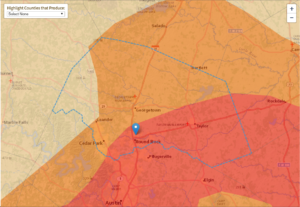 Something to think about
Something to think about
Here in Texas the weather can be a little strange to say the least. One month we could have large amounts of rain and the next could be completely dry. Just think about this past spring of 2019. It rained a total of 17.4 inches, averaging about 4 inches a month. (March-June) Then in July it felt like it just stopped raining and we started heading towards drought conditions. During the hot and dry summer months (July-September) it rained a total of 1.56 inches of rain.
Half of Williamson County is in severe drought as I’m writing this. We aren’t under any water restrictions, but it’s scary to think about the water usage and replenishing ratio. As it gets hotter and dryer here in central Texas, a lot of homeowners start watering their lawns and plants more. I mean nobody wants their lawns and plants to die! Thankfully, this fall has brought down some temperatures and brought us some rain.
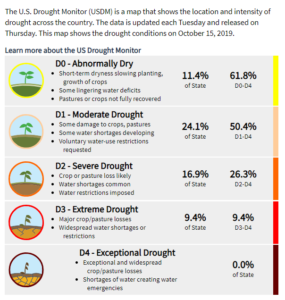
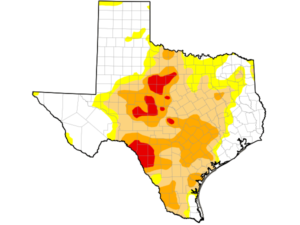
Picture this
This is an example of how much water a common house would use for irrigation. In this scenario, I will be using the average lawn size for a home in Texas.
Front and backyard lawn total- 7,552 sq. ft
A lawn needs about 1 inch of water (0.623 gallons) per square foot during summer months.
So that means I must multiply the 1 inch of water (0.623 gallons) by the amount of square feet there are in that lawn. 7,552 X 0.623= 4,705 gallons
If I water twice a week, that’s 9,410 gallons per week!
Now think about some of those huge commercial properties that have a lot of land to water.
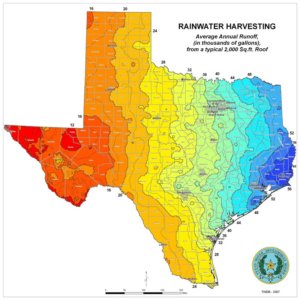
How much water can be collected?
Some might ask, “will I even be able to collect enough water for actual usage?” or “would this really make an impact?”. According to the Texas Water Development Board, for every inch of rainfall that falls on a 2,000 square foot roof, the rainfall collection yields to about 1,000 gallons.
Here’s an example of how much water you could collect during a rainy spring to use during a dry and hot summer.
Rainfall amounts from (March-June 2019) reached 17.40 inches in Central Texas.
According to the US Census, the average home in the US South is 2,392 square feet.
You will get 0.623 gallons (1 inch of water) for one square foot of your roof
2,392 X 0.632= 1,490
1,490 X 17.4= 25,926 gallons
25,926 gallons of water collected during spring. If you wanted, you could use all that rainwater instead of your irrigation for a whole month! It would be especially helpful if the city were to go on mandatory water restrictions during a drought.
Collecting Rainwater can be simple!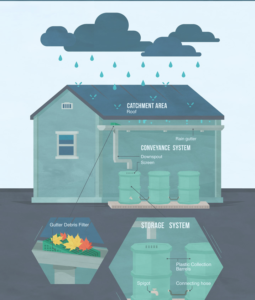
Whether you are going to DYI or buy a container for storing rain, there are three basic components of a rainwater harvesting system.
- Catchment area- roof (impervious cover) that catches rain.
- Conveyance system- transporting rainwater from catchment area to storage (gutters and downspout)
- Storage- container for storing rainwater. You can attach a rain barrel to your home’s downspout.
There are great guides to installing rainwater harvesting systems
The Texas Manual on Rainwater Harvesting from the Texas Water Development Board to learn how to install your own rainwater harvesting system.
American Rainwater Catchment Association
Collecting rainwater is a great way to help save the most precious natural resource, water. It also will help YOU save money! The benefits are endless, and you will be doing your part to help protect Earth.


